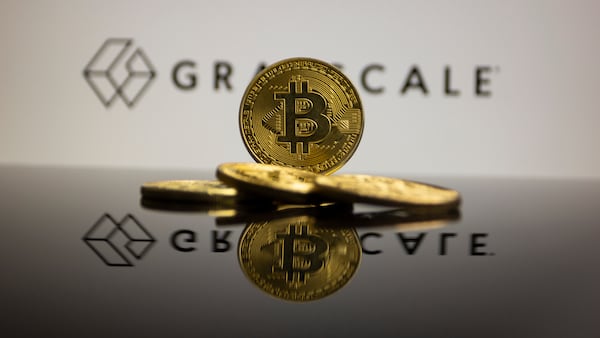- Bitcoin ETFs are forcing Wall Street institutions to educate their clients about cryptocurrencies.
- The CME overtook Binance as the leading Bitcoin derivatives platform in November.
- It now has over 50% more open interest than Binance.
Bitcoin spot exchange-traded funds changed the game for crypto.
Not only did the ETFs establish credibility and legitimise the crypto industry in Wall Street’s eyes, they suddenly forced “some very large distribution networks and very large marketing firms” to promote Bitcoin to their clients, Giovanni Vicioso, CME Group’s head of crypto, told DL News.
The role of investment advisors is now to “help to educate their client base and help them understand why Bitcoin matters,” said Vicioso. CME Group is the parent of the Chicago Mercantile Exchange, one of the world’s largest derivatives exchanges.
“And they have a very familiar product name — the Bitcoin ETFs — as a way to access,” Vicioso added.
Bitcoin spot ETFs, launched in January, enable investors to gain exposure to Bitcoin without the hassle of touching the crypto itself. The familiarity — ETFs have existed in the US since 1993 — means investing in the volatile cryptocurrency is less scary.
Past conversations with clients about Bitcoin used to revolve around basics, Vicioso said.
What is Bitcoin? Why should you be thinking about cryptocurrencies? Are coins being used for illicit purposes? But things have shifted since the ETFs launched.
“Conversations nowadays are more and more around use cases: Why does Bitcoin make sense?” Vicioso said.
And discussions aren’t limited to Bitcoin. Ethereum is also regularly brought up, and along with things that the smart contract technology entails — like tokenisation, DeFi, and web3.
Bitcoin and Ethereum “are just really too large, too big to ignore,” Vicioso said.
Breaking records
Last year, when speculation about Bitcoin ETFs’ approval was at its height, some wondered whether the investment products would end syphoning some of the CME’s trading activity.
The opposite happened. Although open interest — a metric that reflects the total number of futures contracts outstanding — for Bitcoin futures wound down for a short period after the ETFs launched, it’s now soaring to records.
“In terms of additional futures contracts, or even additional ETFs on some of these coins, it’s really a function of more regulatory clarity — whether these cryptocurrencies are considered commodities or securities.”
— Giovanni Vicioso
Whereas CME had $6.3 billion in Bitcoin futures open interest on January 11, it now holds a little over $11.4 billion — roughly 50% more than its closest competitor, Binance.
The exchange has now had six consecutive months of average daily open interest records.
“More participants in the space are using our products to hedge some of the exposures to these ETFs,” said Vicioso.
And it isn’t just Bitcoin. CME’s Ether products have also registered record open interest — March registered a 14% increase in Ether open interest compared with February, and the average daily open interest has been breaking records for five months in a row.
Some of that enthusiasm is channeled through the platform’s micro contracts, dubbed micros, which are seeing “fairly explosive growth,” according to Vicioso.
“As a liquidity provider, you sort of have to wait for a position in the ETFs to build in order to use a large contract to hedge some of those trades,” Vicioso said. However, adding up micro contracts allows these market participants to operate with more flexibility.
Regular Bitcoin futures are worth five Bitcoin — roughly $350,000. But micro contracts are worth a fraction of that: 0.1 Bitcoin, worth about $7,000. The same goes for Ether micros.
Open interest for Bitcoin and Ether micro contracts in March is at around $300 million, double that of February, while average trading daily volume in Bitcoin micro contracts alone is triple February’s at over $414 million.
Vicioso said demand for CME products comes from a diverse mix: hedge funds, banks, both crypto-native and ETF liquidity providers, as well as Bitcoin ETF issuers and authorised participants.
The basis trade
But not everyone is using the platform’s futures to hedge their positions. The ETFs made it easy for market participants to implement one of Wall Street’s favourite market-neutral trading strategies: the basis trade.
By buying Bitcoin ETF shares and shorting futures contracts on the CME, traders can profit from the discrepancies between spot price and the price of futures contracts. While the strategy has its risks, it enables traders to bag Bitcoin returns without making directional bets on the price.
Ethereum ETFs?
As the Securities and Exchange Commission weighs whether to approve a clutch of Ethereum spot ETFs in May, Vicioso said his firm’s data holds clues as to how traders see the market evolving.
He pointed to CME’s reference rates and real-time indexes for 20 other cryptocurrencies — which include prices for projects such as Uniswap, Polygon, Cosmos, and Solana.
Selected by the CME because of their potential use cases, these coins could be good candidates for eventual ETFs down the line.
“In terms of additional futures contracts, or even additional ETFs on some of these coins, it’s really a function of more regulatory clarity — whether these cryptocurrencies are considered commodities or securities,” Vicioso said.
Deepening the Bitcoin and Ethereum focus
Meanwhile, the CME wants to enhance its Bitcoin and Ethereum products.
“The entry point into the market would be Bitcoin, followed by Ether,” Vicioso said. The company has been improving access to its existing products by adding clearing firms and brokers.
“Access had been a concern for some,” he said. “But we’ve made some inroads there and our markets are now more accessible to a wider swath of clients.”
One product the exchange recently launched was micro euro Bitcoin and Ether futures — which work the same as the original micro futures contracts, except they are dominated in euros, not US dollars.
The new product should make it more efficient for market participants based in Europe to hedge their activity in euro-denominated investment vehicles.
“The European market is well positioned for growth,” Vicioso said, thanks to the Markets in Crypto-Assets Regulation regulatory framework passed by the European Union in 2023.
“We’ll continue to work lockstep with clients, to better understand and anticipate their needs, which really is the driving force behind everything that we do,” he added.
Tom Carreras is a markets correspondent at DL News. Got a tip about Bitcoin and Ethereum futures? Reach out at tcarreras@dlnews.com







